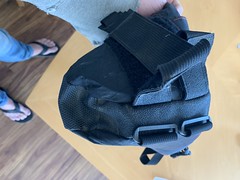Burkina Faso is a semi-arid, landlocked country in the dead center of the bulge of West Africa. It’s located in the buffer zone (known as the Sahel) between the Sahara desert to the north, and the more tropical, coastal areas to the south. As you might expect given this geography and the lack of many natural resources, Burkina is one of the poorest countries in the world, typically in the bottom five on the UN’s development index.
While it has known relative stability in recent years, Burkina’s early post-colonial history was punctuated with multiple coups d’etat. Burkina’s most colorful leader was Thomas Sankara, the Che Guevara of West Africa.
Before being assassinated by one of his closest friends in 1987 (by the current president of Burkina Faso, Blaise Compaore), Sankara did much to popularize the use of bicycles. As anyone who has walked the streets of Burkina’s cities can attest, bikes and mopeds still outnumber cars by 10 to 1.
The Model-T of Burkina bicycles reflects the country’s colonial heritage, looking very much like an old French city bike, 650B wheels and all. While generally cheap and falling apart, these bikes see a lot of miles, and there were plenty of young guys on these who could keep up with me at over 20mph, at least for a good stretch!

Burkina also has the unique honor of hosting the only UCI legal bike race in Sub-Saharan Africa, the Tour de Faso. During my time in Burkina, I had the chance to see it pass through my town twice:


Before moving to San Diego in 2008, my wife and I spent two years living in Burkina’s second biggest city, Bobo Dioulasso. Since I was working out of my home and had some flexibility in my schedule, there were many opportunities to explore the countryside by bike. The main limitation was the 100+ degree heat, which typically required starting my rides at sunrise in order to return home before a complete meltdown.
Given the paucity of paved roads in the country, riding in Burkina means mixed surface rough riding, as the only way to make a loop is to combine stretches of pavement and dirt road. This is no place for 700×23 road tires! The bike I first brought over with me was a Surly Cross-Check with 700×40 tires, set up as a single speed:

For the most part, the bike did very well on the backroads of Bobo Dioulasso:


Many of the roads I explored took me out through different fields and plantations:


As I was pretty much the only white guy in those parts riding a bicycle, I drew some pretty interesting stares from the folks in villages that I rode through, and the few times that I had to change a flat created sizable crowds (of course, just about any white person in a small village is an event, whether biking or not).




In general, the scenery in the countryside of Burkina Faso doesn’t exactly make it destination-cycling worthy, but occasionally you do get a nice shot or two:



Though much of Burkina is flattish, after my first year there on a single speed Surly Cross-Check my knee started to bother me a bit. So, I did the only sensible thing you could do and designed a Titanium S&S coupled, Rohloff-equipped adventure bike, which is still my main rough riding bike today. The bike was built by Black Sheep bikes in Fort Collins, Colorado, and I picked it up when I was back in the states for vacation one year:

You’ll also see young Zayzay in this photo, the Burkina dog that we brought back with us to the United States.
Heat aside, biking in Burkina was a lot of fun, and was the perfect way to get out of town and explore the countryside and small villages off the main roads. I miss being able to be “in the bush” after only 25 min or so of riding. I also miss being able to do so much mixed surface rough riding right from my front door. Here in San Diego, you have to work a bit harder if you want to enjoy low to no traffic dirt roads.






